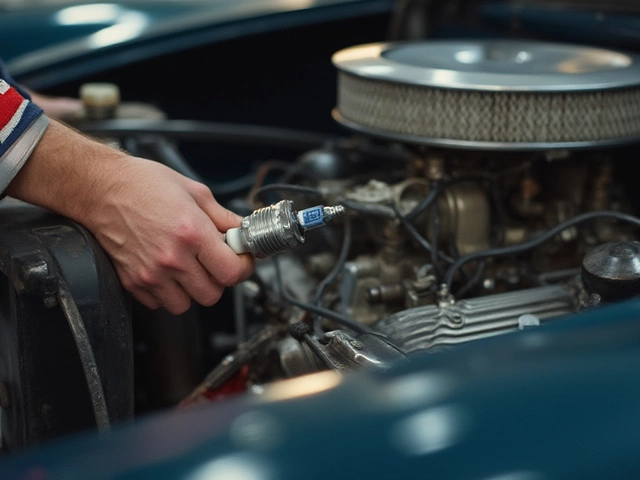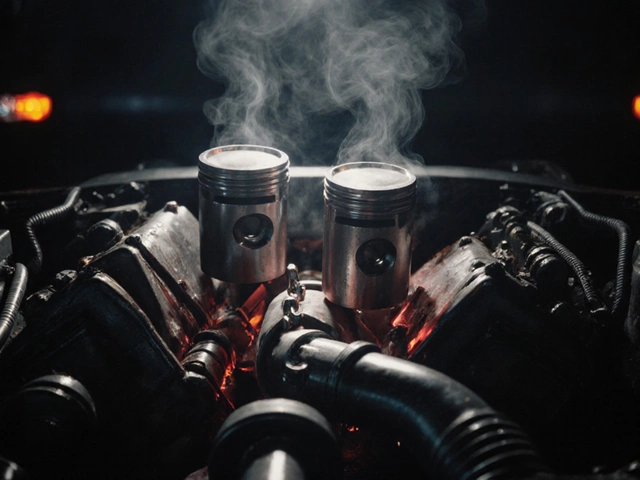Imagine cruising down the road on a perfect sunny day, only to hear a strange clattering sound coming from under the hood. It's a noise that makes any car owner anxious, and it might be a sign your vehicle is low on oil.
Understanding how your car behaves when it's lacking this vital fluid is key to maintaining its health. Look out for warning signs and symptoms that suggest your ride is running on low reserves.
Aside from lights on the dashboard screaming for attention, there could be performance hiccups and engine sounds that won't quit.
This guide will help you become a more informed car owner, spotting these signs before they turn into costly repairs. We'll also share tips on how to check your oil levels and keep your car purring smoothly like a contented cat — or, in my case, like Rufus chasing a squirrel.
- Why Oil is Essential for Your Car
- Warning Indicators of Low Oil
- Performance Problems to Watch
- Avoiding Engine Damage
- Checking Oil Properly
- Tips for Regular Maintenance
Why Oil is Essential for Your Car
Imagine your car's engine as the heart of the vehicle, tirelessly pumping life through its pistons and cylinders. Now, consider the engine oil as the blood that keeps this heart active and efficient. Without this vital fluid, the heart would seize and stop, much like your engine would if deprived of oil. The oil doesn’t just lubricate, which is paramount to reducing friction between moving parts; it also cleans, cools, and provides a sealant between components, ensuring that your car delivers optimum performance.
Engine oil travels through intricate passages and components, collecting debris and microscopic particles that accumulate over time. The oil filter captures these contaminants, but the oil itself also plays a role in keeping these particles suspended, preventing them from settling and grinding the engine to a halt. It’s this mutual role of lubrication and cleaning that makes car maintenance reliant on regular oil changes. When oil levels drop, the engine runs hotter, and parts start to wear down faster. Think of oil as a cooling blanket that dissipates heat away from areas that experience intense friction.
"Ignoring low oil levels is akin to inviting disaster," warns renowned automotive expert, Bob Falfa. "The oil not only keeps the vehicle’s components moving smoothly, it actively prevents them from warping and breaking under heat and pressure."
Statistics show that engines running low on oil are more likely to blow a gasket or experience a seizing, potentially leading to vast repair expenses or even total engine failure. This is why low oil symptoms should never be ignored. Oil also acts as a sealant, contributing to the engine's efficiency by filling gaps between piston rings and cylinder walls, thereby enhancing compression and power delivery.
Understanding the multipurpose role of oil reveals why it is often referred to as the lifeblood of an engine. But how often you change the oil can vary greatly depending on the type of oil your vehicle uses, your driving habits, and the climate in which you operate your car. Opting for high-quality synthetic oils, for instance, can extend the life of an engine, offering better performance and longer intervals between changes. Paying attention to these aspects is central to effective car care strategies.
Warning Indicators of Low Oil
When your car is running low on engine oil, it's akin to being dehydrated on a hot summer's day. Your engine might start exhibiting signs, almost like a cry for help. One of the first and most obvious indicators is the oil pressure warning light on your dashboard. This light isn't just a suggestion; it's telling you that your car's oil pressure is lower than ideal. Low oil pressure could mean your car maintenance schedule needs some urgent attention.
While the light may be the most obvious signal, cars often have other ways of communicating their need for oil. You might start to hear unusual ticking or rumbling noises from the engine, a sign that the lifters and other components lack proper lubrication. This noise is one that many mechanics recognize immediately as a symptom of oil starvation. The performance might also take a hit, with your vehicle feeling less responsive and perhaps even experiencing stalling.
A less recognized but still crucial indicator is exhaust smoke. Normally, it's nearly invisible, but when your vehicle is low on oil, the smoke could become much darker and more noticeable. It's your car's way of waving a red flag, alerting you to potential oil leaks or burning issues within the engine. If you sniff odd smells wafting into the cabin, sometimes earthy or burnt, don't ignore them. These scents might be more than annoying—they could signal your engine is overheated due to inadequate lubrication.
In a study conducted by the National Institute for Automotive Service Excellence (ASE), it was found that nearly 50% of engine failures could be traced back to insufficient lubrication and low oil levels. It’s the invisible hand that keeps everything inside the engine moving smoothly and efficiently. Paying heed to these signs can help you avoid costly repairs or even the need for a complete engine overhaul down the line.
"Timely oil changes and maintaining proper oil levels are your cheapest insurance against engine failures," says the ASE.
Of course, noticing these indicators doesn't mean it's the end of the road. But it does mean you need to take action quickly. Whether it's a top-up or a thorough check-up, addressing these warning signs of low car oil promptly can ensure your vehicle runs smoothly and reliably, allowing you to enjoy more worry-free drives.

Performance Problems to Watch
When engine oil levels drop, the first and most noticeable change occurs in your car’s performance. If you don't pay attention, this can snowball into critical issues. Low oil affects the engine's ability to lubricate moving parts efficiently, leading to increased friction. This friction generates excess heat, which causes parts to expand more than usual, setting up a disastrous domino effect. As the heat builds, your engine's performance will dip. You might experience a sluggish acceleration, making it hard to pick up speed while merging onto highways. A car that seems to groan instead of roar at high speeds is often crying out for an oil top-up.
An observant driver might notice the engine’s temperature creeping up on the gauge. Not to alarm you, but excessive heat can warp metal components, stretching and permanently altering engine parts. This is not just a minor inconvenience; it can lead to complete engine failure over time. A particularly poignant insight from the 'Automotive Engine Guide' states, "Maintaining the correct oil level is as important as feeding your car's soul," adding that an engine deprived of oil is like a runner deprived of air, bound to falter at some point.
Listening to your car is paramount; the once-muted purr of your engine might now resemble the angry growl of an annoyed dog. If you’re hearing more knocks and rumbles than you remember, it's a glaring sign your engine isn't happy. Those sounds are basically your engine parts clanking against each other without enough oil to cushion them. The dreaded knocking sounds might bring visions of a huge repair bill, so catching it early is key to preventing bank account grief.
Another performance clue can be seen in the vehicle's fuel economy. A well-lubricated engine runs smooth, but a thirsty engine struggling due to low oil makes the car work much harder than it should. Like a ship battling against the tide, your car will consume more fuel just to maintain normalcy on the road. Therefore, frequent stops at gas stations might indicate more than just a heavy right foot. Looking after your car maintenance habits by ensuring adequate oil levels can lead to savings at the pump—a happy consequence for both engine and wallet.
Sometimes, the signs are clearly visible, or in this case, smellable. Burning oil has a distinct odor, unmissable when it seeps into the car’s cabin. If you catch a whiff of something burnt, it might mean oil is leaking onto hot engine parts due to insufficient lubrication. Also, bluish smoke from the exhaust can be a visual giveaway. A balanced state helps your car run clean, keeping emissions at bay. Seeing smoke should prompt an immediate action plan—get that oil level checked before it sends your car into the shop for more than just an oil refill.
Avoiding Engine Damage
Ensuring that your engine oil is always at the optimal level is like giving your car a lifeline. It's more than just oil; it's the vital fluid that keeps everything running smoothly, preventing those fiery heartbeats from failing. There's nothing worse than realizing you've pushed your engine too far, only when it's too late. Understanding how to properly maintain and monitor your oil can ultimately save you from unpleasant surprises down the road.
To start, familiarize yourself with the car's manual, which holds an abundance of insights into your vehicle's engine oil requirements. The manufacturer specifies the right type of oil for your car, and sticking to these guidelines is crucial. While it might be tempting to save a few bucks on lower-grade alternatives, it can lead to diminished engine performance in the long run. Regularly checking your dipstick and oil levels should be a habitual practice. Generally, check your oil at least once a month, and more frequently if you notice signs of leakage or unusual noises.
"Oil is the lifeblood of your engine, and neglecting it can be one of the fastest routes to engine trouble," advises the Auto Care Association.
Avoiding engine damage isn't just about topping off your oil; it's also about recognizing potential leaks. Check underneath your vehicle regularly for any pooling oil. Ignoring an oil leak, no matter how small, can lead to catastrophic failure if left unchecked. Keep an eye on the engine's oil pressure light — it doesn't lie. If it's illuminated, there might be a more serious issue than just low oil.
| Mileage | Oil Type | Change Frequency |
|---|---|---|
| Up to 3,000 miles | Conventional | Every 3,000 miles |
| 3,000 - 5,000 miles | Synthetic Blend | Every 5,000 miles |
| 5,000 - 10,000 miles | Full Synthetic | Every 7,500 miles |
Embrace technology's helping hand; some modern vehicles come equipped with oil quality sensors. These sensors provide real-time data on your oil's life and even remind you when it's time to change. If this feature is available in your vehicle, pay attention to it. Your car will often reward your attentiveness with sustained performance and longevity. In case of doubt or error alerts, don't hesitate to consult a professional mechanic. Having a mechanic inspect your vehicle can unveil underlying problems that regular inspections may overlook.
Remember, investing in high-quality oil and timely changes is far more cost-effective than replacing an engine. By keeping up with your car maintenance, monitoring oil levels, and promptly addressing any issues, you're setting your car up for a long and healthy life on the road. Letting oil levels slip isn't just risky; it invites unforeseen expenses that are sure to burn a hole in your pocket. So take care to keep your engine's veins clean and full — your vehicle, like a trusted old friend, will return the favor.

Checking Oil Properly
To keep your car's engine running efficiently, it’s crucial to monitor its oil levels regularly. This process isn’t just a routine maintenance tip but an essential step to prevent engine damage. Start by ensuring your car is parked on a level surface, as slanting can affect the accuracy of the oil reading. It’s best to check the oil when the engine is cool. First, pop open the hood and locate the dipstick, typically marked with a yellow handle. Pull the dipstick out and wipe it clean with a rag, removing any existing oil.
After cleaning, reinsert the dipstick fully into its tube before pulling it out once more for a fresh reading. Check where the oil film ends; it should lie between the 'Min' and 'Max' marks on the dipstick. If the oil level is closer to the 'Min' mark or below, it’s time for a top-up. Make sure you are using the right type of engine oil for your car. Referencing the owner’s manual can be beneficial for this. Car maintenance habits like these go a long way in prolonging engine life.
Color and consistency are pivotal when gauging oil quality. Ideally, engine oil should have a light brown or amber hue. If it appears dark, gritty, or has a burnt smell, it might need changing. As a general tip, don't confuse grime with a well-worn oil. It's also essential to check the manufacturer's recommendations on oil change intervals; some suggest changes every 3,000 miles, while others recommend longer intervals.
"Regular oil changes and checks are key in ensuring your car runs smoothly," says Jane Simmons, an automotive expert from AutoCare Center.
If you’re curious about how often you should be checking the oil, monthly checks are a good rule of thumb. However, if you're preparing for a long drive, it pays to check beforehand. Preventive care is always smarter than reactive fixes.
Many modern cars provide electronic oil level monitoring, but there’s value in knowing how to perform a manual inspection. Technology might fail, but the classic dipstick check remains a reliable method. Keeping tabs on low oil symptoms means staying alert to potential issues before they escalate.
Tips for Regular Maintenance
Regular maintenance is the lifeblood of keeping your car humming smoothly and avoiding any unexpected roadside calamities. Imagine your vehicle not as just a means of transportation but as a companion in need of care and attention, much like how Rufus relies on me for his walks and food every day. It starts with a simple routine—checking your engine oil often. Ideally, you should peek under the hood once a month to ensure it’s at the right level and consistency. This habit gives you a chance to spot potential issues early, be it a leak or just the natural consumption of oil by the engine.
Another crucial aspect is the regular oil change. Depending on whether you use synthetic or regular oil, the interval may vary. Modern vehicles and oils allow you to stretch it to about 7,000 to 10,000 miles for full synthetic oils. However, it's always wise to refer to the owner’s manual—it’s a treasure trove of guidelines specific to your car. Swapping out your oil according to schedule not only keeps the engine parts lubricated but also clears out dirt and debris that naturally accumulate over time. Remember, dirty oil robs your engine of efficiency.
Speaking of efficiency, heed to those low oil symptoms. If your dashboard issues a warning light, your engine's not crying wolf. It's emphasizing that immediate attention is necessary. It's crucial not to hit the panic button, as these warnings are designed to alert you before any serious damage takes place. As a precautionary principle, don't ignore mysterious noises, unusual burning smells, or rough idle, as they might signal deeper issues beneath the surface. These are not merely sounds but signals, urging you to act fast.
"Preventive maintenance is a crucial part of vehicle ownership," writes John Davis, automotive expert. "It doesn't just help avoid expenses; it's a true investment in your car's lifespan."
An easy yet often neglected task is to replace the oil filter with every oil change. Just as important as replacing oil, the filter catches all the tiny bits of dirt and metal that could potentially harm the engine. Neglecting this could mean you're just pouring fresh oil through the same cloggy filter, denying its full benefits.
To make things less overwhelming, keep a maintenance record. Jot down dates, mileage at every oil change, and any other maintenance activity to stay organized. This information not only serves you well in keeping track but can be a blessing when selling your car as proof of its regular upkeep. Plus, sharing tips with fellow car enthusiasts or in online forums can open you to a world of knowledge and camaraderie. Treat these as learning moments, not chores, and you'll find yourself enjoying the process.
On top of oil-related tasks, keeping your car maintenance routine robust includes tasks like tire rotation, brake checks, and fluid top-ups. Oftentimes, car care is more about seamless orchestration rather than isolated tasks. Ensure that your tires are inflated to the manufacturer's specified pressure levels to not only safeguard your ride but also to promote fuel efficiency. Mark calendar reminders for these activities too, so they don't slip into oblivion among the chaos of daily living.






